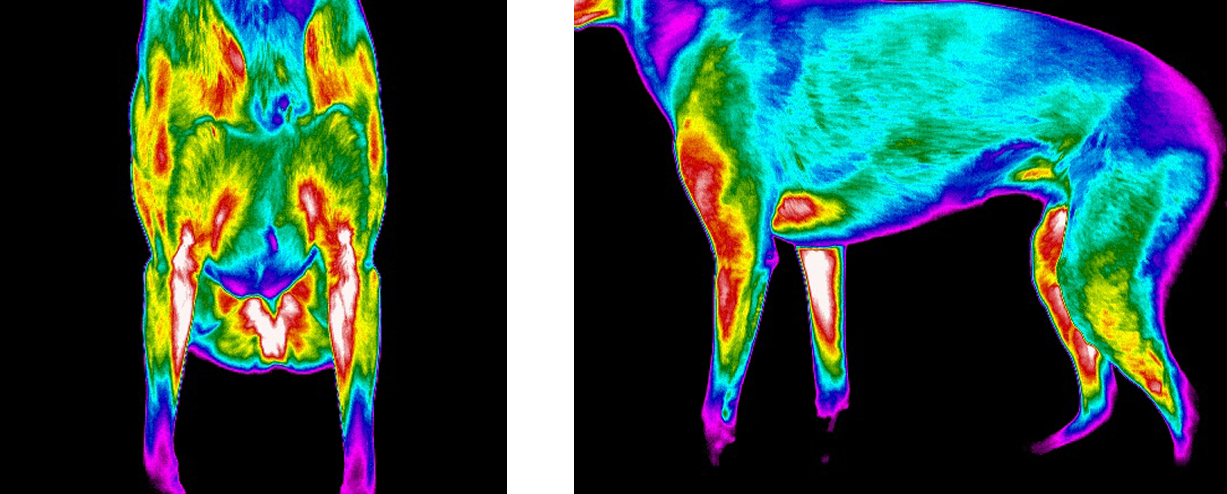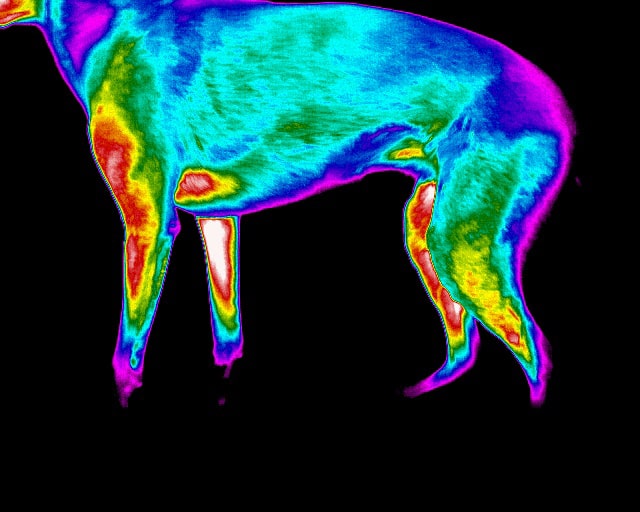Canine Sports - Improving Welfare and Competitiveness with Thermal Imaging
Contributed by: Tori Acres, BEng(Mech)/BIT, CPCFT
There is no doubt that dog sports can be fun for both dogs and handlers; looking after the welfare of canine athletes is imperative to ensure they can enjoy their sport and perform at a competitive level. This article looks at utilizing thermal imaging to gain a deeper insight into the dog's physiological state and how information gained through Canine Sports Thermography allows handlers to make informed choices that promote the welfare of their athletes and competitive performances.
Canine Athletes in Dog Sports
With a large variety of dog sports to choose from and a vast array of dog breeds, there is a sport for every dog-handler team. Once the dog-sport passion has been ignited, keeping dogs in optimal form becomes a high priority. Handlers want to ensure the well-being of their canine athlete and maintain the ability to participate in the chosen sport.
Welfare and competition performance are not mutually exclusive. A dog unable to compete or whose function is impaired due to injury cannot perform at their optimal level. Regardless of the handler's motivation, winning, or simply enjoying the activity, we want to ensure the dogs are as healthy as they can be. Seeing them reach their full potential without missing time from injury is incredibly fulfilling.
Handlers can use proactive means of monitoring their canine athlete's welfare; this allows them to make informed choices, reducing risk factors associated with dog sports. This is where thermal imaging plays a vital role; it is used in human and equine performance sports and can also be applied as a cost-effective tool in canine sports, giving handlers a greater awareness of their dog's physiological state.

Thermal Imaging: Understanding your Dog's Physiological State
Thermal imaging uses a special camera that detects the infrared energy emitted by a body. It is a non-invasive, objective means to measure the thermal profile of the dog. Seeing the locations and magnitudes of thermal variations or abnormalities is easy with the colorful visual images created in the software application, making it a powerful tool when used in canine sports.
Asymmetries in the thermal profile may indicate that the canine athlete has chronic or acute dysfunctions stemming from neurological issues, joint inflammation, soft tissue sprains, muscle imbalances or other causes. Using pre-event static images, we can build a profile of the athlete; using this as a baseline, we can monitor changes in the dog’s physiological heat map after event heats and post-event. Comparing these static images can be helpful in the early detection of injury that might have otherwise gone undetected. Significant findings should be referred to a veterinarian for diagnosis so the dog can receive the best care.
In addition to static images, thermal video can monitor the dog in real-time. Gross changes in thermal profile are likely to be metabolic in nature, driven by emotions or environmental factors that cause a physiological response. Understanding and interpreting thermal video in uncontrolled environments requires some knowledge of heat transfer and emissivity, which is discussed in this webinar. However, we can still learn a lot about dogs' responses at sporting events by tracking their warm-up and cool-down with thermal video.
Benefits of Thermal Monitoring of the Canine Athlete
The two modes of applying thermal imaging to canine sports are static images and video. Both have benefits and can be deployed strategically throughout the dog sport event. This will help handlers make informed choices that lead to improved welfare or competitive edge.
In the webinar Thermal Imaging in Canine Sports - Improving Welfare for the Individual Athlete, we look at two case studies, analyzing their static images to ascertain their thermal asymmetries and using video to monitor their physiological responses during warm-up and holding phases of a flyball national championship event.
The videos showed interesting thermo-regulatory responses to the environment and the emotions associated with the event. This was valuable information for the handlers, who could adjust conditions accordingly for individual dogs. The information provided through the thermal video is objective and helped handlers gain greater insight into their dog and its immediate welfare needs.
The wellness checks (which used static images) showed common imbalances in both the studied athletes and issues that were otherwise hidden. Monitoring risks to individual dogs associated with canine sports injuries through thermal imaging is empowering for handlers; they can see the physiological changes in their dog's body throughout an event.
Thermal imaging is also a valuable tool in assessing the effectiveness of specific equipment. Garments such as coats and gear such as bedding or flooring can be analyzed to determine how well they insulate, emit or radiate heat. This means dogs can receive care based on their individual needs, keeping them in an optimal thermal state leading up to their competition.
When used in team sports such as Flyball, thermal imaging can help teams select which dogs should run. In non-team sports such as agility, handlers may find it helpful to perform pre-event screening. They can remove their dog from the competition if significant thermal asymmetries are identified or adapt their strategy if minor issues are seen. Running a compromised dog increases the risk of injury, potentially putting the dog out of action for weeks or months – which is not fun for the dogs or handlers.

Using Thermal Images to Adapt a Fitness Plan
Where imbalances are identified, handlers can work with a Certified Professional Canine Fitness Trainer to adapt the warm-up, cool-down, and training phases. Real-time monitoring means changes can be made immediately, which is especially important during the warm-up. The video in our webinar reveals how specific the individual dog’s response can be to the environment; identifying the needs of each dog means their routine can be customized to their physiological requirements.
Evaluating exercise recovery is another area in which thermal imaging has proven helpful in human sports. This can be applied to canine sports, monitoring the changes that occur during the recovery process or cool down. Understanding the duration of the recovery period allows canine fitness trainers to identify areas of improvement and modify the dog's fitness plan accordingly.
Conclusion
Thermal imaging used in dog sports gives handlers a deeper level of insight into the well-being of their dog. Real-time changes can be made to the dog’s activity or the environment when thermal irregularities are identified. It helps optimize their ability to perform safely and competitively. Significant thermal asymmetries that present before an event or show up when comparing pre and post-event images can be referred to a veterinarian, helping to guide a diagnosis. Monitoring and improving the welfare needs of dogs competing in canine sports is crucial. It affects their immediate performance and the longevity of their ability to continue competing. Increasing awareness and understanding promotes healthier, happier dogs and contented owners too.
| Interested in learning more about thermal imaging? Request a demonstration with Digatherm and discover how veterinary thermography can help you find problem areas faster and easily monitor treatment progress. |

